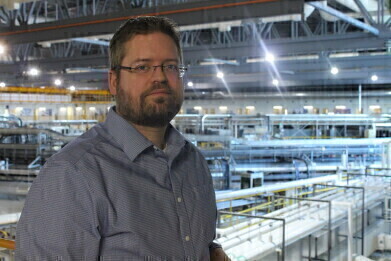-
 Dr David Cooper (Credit: Canadian Light Source)
Dr David Cooper (Credit: Canadian Light Source) -
 Dr Kim Harrison (Credit: Canadian Light Source)
Dr Kim Harrison (Credit: Canadian Light Source)
News & Views
New imaging technique holds light for Osteoporosis Therapies
Jan 19 2023
A research team from the College of Medicine at the University of Saskatchewan has developed a new approach to imaging that could help to improve outcomes for osteoporosis sufferers, said to number more than 2.3 million people in Canada The technique, which detects changes in bone tissue far more quickly than the bone densitometry scans currently used in health care, could lead to improved drug treatment for the condition.
Using the BMIT beamline of the Canadian Light Source at the University of Saskatchewan, Dr. David Cooper and colleagues were able to see the incredibly tiny pores inside cortical bone, the dense outer surface of bone that accounts for the majority of bone mass. These pores change over time, showing how bone tissue is continuously removed and replaced.
The researchers stimulated this bone turnover using parathyroid hormone, then tracked the changes in the pores of the cortical bone in as little as 14 days.
“In humans, the pores we were looking at are about the width of a few hairs – a quarter of a millimetre – and in rabbits they’re about half that size,” said Cooper, whose latest breakthrough builds on a decade’s worth of work in this area. “Using micro-computed tomography (micro-CT) we were, for the first time, able to see the shapes of these pores and actually track them over time.”
Study lead Dr. Kim Harrison said this research would not have been possible using conventional X-ray techniques. “This uses refractive qualities between soft and hard tissues which highlights these pores within the bone and makes it easier to image and track the changes,” she said.
“This really is the establishment of a fundamentally new way of looking at bone turnover,” said Cooper. “Nobody has ever been able to do this before in terms of tracking the pores.”
Current osteoporosis diagnostic testing, done by bone density scans, is “a very blunt instrument,” Cooper added. “It might take years for changes to be detectable. We’re detecting these things over weeks in animals. It could have a rapid impact on how current drugs used in the treatment of osteoporosis are deployed.”
More information online
Digital Edition
ILM 49.5 July
July 2024
Chromatography Articles - Understanding PFAS: Analysis and Implications Mass Spectrometry & Spectroscopy Articles - MS detection of Alzheimer’s blood-based biomarkers LIMS - Essent...
View all digital editions
Events
Jul 28 2024 San Diego, CA USA
Jul 30 2024 Jakarta, Indonesia
Jul 31 2024 Chengdu, China
ACS National Meeting - Fall 2024
Aug 18 2024 Denver, CO, USA
Aug 25 2024 Copenhagen, Denmark

.jpg)

24_06.jpg)













